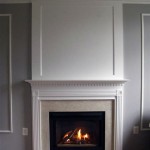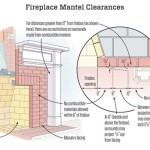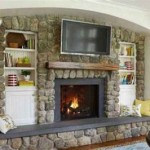Cost To Build And Install Fireplace Mantel
A fireplace mantel serves both functional and aesthetic purposes within a home. It acts as a protective barrier against the heat rising from the fireplace, shielding combustible materials like walls and decorations. Simultaneously, it provides a focal point and visual anchor for the room, enhancing its overall design and ambiance. Therefore, understanding the costs associated with building and installing a fireplace mantel is crucial for homeowners looking to upgrade or customize their living spaces.
The total cost of building and installing a fireplace mantel is influenced by a variety of factors, including the material used, the complexity of the design, the size of the mantel, and whether professional installation is required. This article will delve into these factors, providing a comprehensive overview of the costs involved in creating a fireplace mantel.
Factors Affecting the Cost of a Fireplace Mantel
Several key elements contribute significantly to the overall cost of building and installing a fireplace mantel. These factors need careful consideration during the planning phase to ensure the project aligns with the budgetary constraints and design preferences.
Material Selection: The material chosen for the mantel forms the bedrock of its cost. Options range from relatively inexpensive materials like pine and MDF (Medium-Density Fiberboard) to more costly options such as hardwood (oak, cherry, maple), stone (granite, marble, limestone), and even concrete or metal. Each material possesses unique properties in terms of durability, aesthetics, and ease of workability, which directly influence its price.
Pine and MDF are often the most budget-friendly choices, offering affordability and versatility. They can be easily painted or stained to achieve the desired look. However, they may lack the inherent character and longevity of hardwoods. Hardwoods, with their natural grain patterns and superior durability, command a higher price point. Oak, known for its strength and prominent grain, is a popular choice. Cherry offers a rich, reddish-brown hue and elegant appearance, while maple provides a lighter, more contemporary feel. Each hardwood species will vary in cost based on availability and grade.
Stone mantels present a completely different aesthetic, exuding a sense of permanence and grandeur. Granite, marble, and limestone are common choices, each with distinct veining and color variations. Stone is highly durable and heat-resistant but requires specialized tools and expertise for cutting and installation, contributing to higher labor costs. The quality and rarity of the stone itself will significantly affect the price. Concrete mantels offer a modern, industrial look and can be customized with various finishes and textures. Metal mantels, often made of steel or wrought iron, provide a sleek, contemporary feel and can be fabricated in various designs.
Design Complexity: The intricacy of the mantel design plays a crucial role in determining the construction and installation costs. Simple, minimalist designs with clean lines are generally less expensive to fabricate and install compared to elaborate, ornate designs featuring intricate carvings, moldings, or custom details. A simple pine shelf acting as a mantel will cost significantly less than a handcrafted, multi-layered oak mantel with detailed cornices and pilasters.
Custom designs, requiring specialized woodworking or stoneworking techniques, will inevitably increase the labor costs. The time and skill involved in creating complex shapes, carving intricate details, or matching existing architectural elements will all contribute to a higher overall project cost.
Mantel Size: The size of the mantel directly impacts the material costs. A larger mantel requires more material, naturally increasing the expense. Furthermore, larger mantels may require more substantial support structures and specialized installation techniques, which can further influence the labor costs.
Consider the proportions of the fireplace and the surrounding wall space when determining the appropriate mantel size. A mantel that is too small may appear insignificant, while a mantel that is too large can overwhelm the space. Accurate measurements are essential to ensure the mantel fits properly and complements the overall design.
Installation Costs: The method of installation, whether DIY or professional, also impacts the overall cost. DIY installation can save on labor costs but requires the homeowner to possess the necessary skills, tools, and experience. Improper installation can lead to structural issues, safety hazards, or aesthetic imperfections.
Professional installation ensures the mantel is properly secured, level, and aligned with the surrounding wall. Experienced installers possess the knowledge and equipment to handle various types of materials and designs. While professional installation adds to the cost, it provides peace of mind knowing the job is done correctly and safely. The cost of professional installation will vary depending on the complexity of the project, the location, and the experience of the installer.
Estimating the Cost of Materials
Accurately estimating the cost of materials is a crucial step in budgeting for a fireplace mantel project. This involves researching the price of different materials, determining the quantity needed, and factoring in potential waste or errors.
Wood Mantels: For wood mantels, the cost of lumber will vary depending on the species, grade, and dimensions. Softwoods like pine are generally less expensive than hardwoods like oak or cherry. The grade of the lumber refers to its quality and appearance, with higher grades being more expensive. The dimensions of the lumber will also affect the price, with thicker and wider boards costing more.
Visit local lumber yards or home improvement stores to compare prices and assess the quality of different wood options. Consider purchasing slightly more lumber than needed to account for potential mistakes or imperfections. The surplus can be used for smaller projects or kept as a reserve.
Stone Mantels: Stone mantels, such as granite or marble, are typically sourced from stone suppliers or fabricators. The cost of stone will vary depending on the type, color, veining, and thickness. Granite is generally more affordable than marble, but both are significantly more expensive than wood. The complexity of the stone's pattern and the rarity of the color will also influence the price.
Obtain quotes from multiple stone suppliers to compare prices and negotiate the best deal. Consider visiting their showrooms to view samples of different stone options and assess their quality. Factor in the cost of cutting and finishing the stone, as this may require specialized equipment and expertise.
Other Materials: In addition to the primary material used for the mantel, other materials may be required, such as screws, nails, adhesives, stains, paints, sealants, and hardware. These costs can add up, so it is important to factor them into the overall budget. Create a detailed list of all the materials needed and research their prices at local hardware stores or online retailers.
Consider purchasing materials in bulk to save money, especially if you plan on undertaking other home improvement projects in the future. Look for discounts or promotions offered by retailers to further reduce costs.
Installation Considerations and Costs
The installation process significantly impacts the final cost of the fireplace mantel project. It's important to determine whether a DIY installation is feasible or if professional assistance is necessary.
DIY Installation: A DIY installation can save on labor costs, but it requires a strong understanding of carpentry or stoneworking techniques. The homeowner must have the necessary tools, such as a level, drill, saw, and measuring tape. Expertise in safely mounting the mantel to the wall is crucial. Incorrect installation can lead to the mantel being unstable or even falling, which poses a safety hazard.
A DIY installation is most suitable for simpler mantel designs, such as a straightforward wooden shelf. Complex designs or stone mantels often require specialized tools and expertise, making professional installation a more appropriate choice. Research the necessary steps and safety precautions before attempting a DIY installation. Consult online resources, tutorials, or instructional manuals to gain a better understanding of the process.
Professional Installation: Professional installation ensures the mantel is properly installed according to building codes and safety standards. Experienced installers possess the knowledge and equipment to handle various materials and designs. They can also provide expert advice on the best placement and mounting techniques.
The cost of professional installation will vary depending on the complexity of the project, the location, and the experience of the installer. Obtain quotes from multiple contractors and compare their prices and credentials. Check their references and reviews to ensure they have a good reputation. A detailed contract outlining the scope of work, payment terms, and warranty information is essential before commencing the project.

Fireplace Installation Cost 2024 Gas Wood Burning Electric

ᑕ❶ᑐ How Much Do Fireplace Built Ins Cost Get The Guide

ᑕ❶ᑐ How Much Do Fireplace Built Ins Cost Get The Guide

ᑕ❶ᑐ How Much Do Fireplace Built Ins Cost Get The Guide

How Much Does A Fireplace Remodel Cost 2024

How To Build A Fireplace Mantel In Only 5 Steps

Fireplace Mantel Installation Before And After

How To Install A Floating Mantle The Easy Way In Just One Afternoon

Diy Rustic Fireplace Mantel Domestically Speaking

How To Make An Easy Diy Fireplace Mantel Sprucing Up Mamahood








